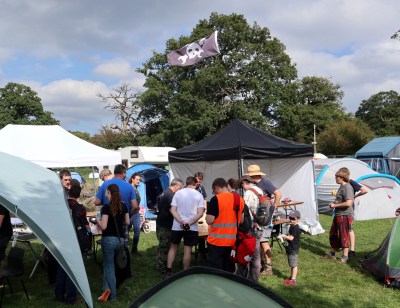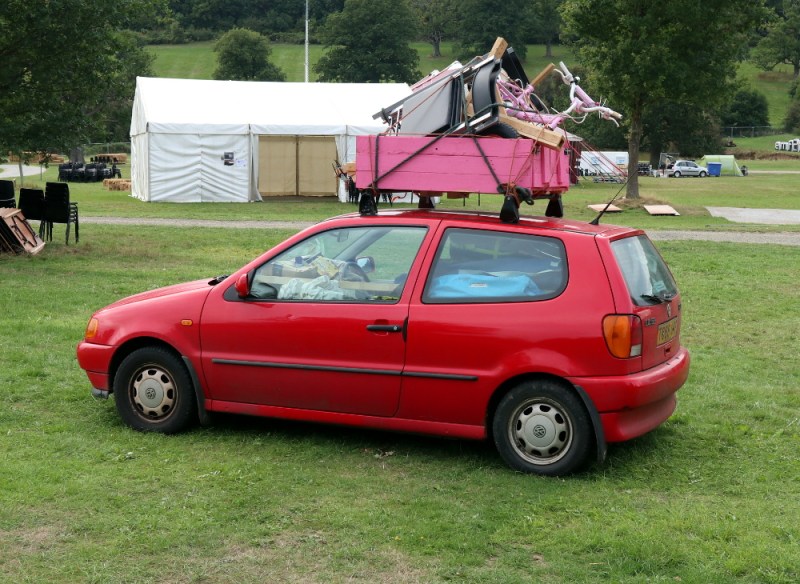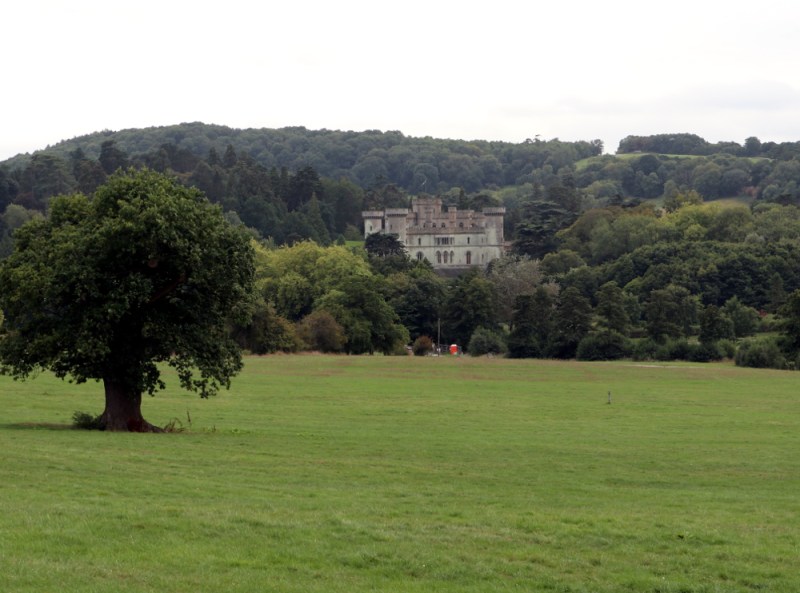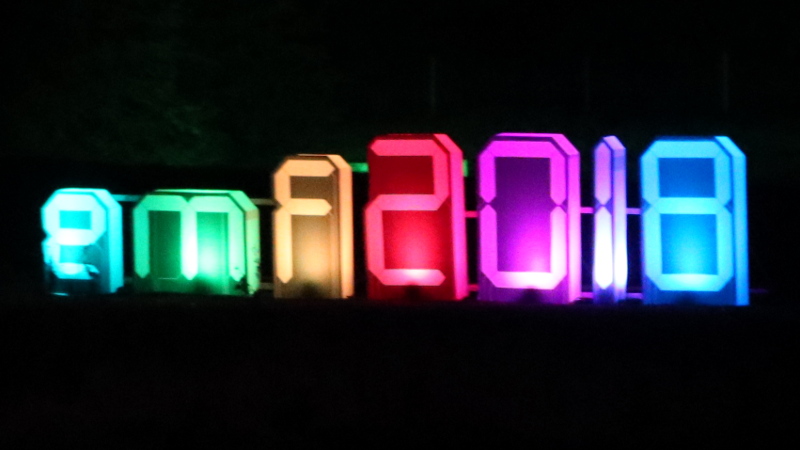This summer’s Electromagnetic Field hacker camp in a field in western England gave many of the European side of our community their big fix of cool stuff for the year.
Some lucky individuals can spend the year as perpetual travelers, landing in a new country every week or so for the latest in the global round of camps. For the rest of us it is likely that there will be one main event each year that is the highlight, your annual fill of all that our global community has to offer. For many Europeans the main event was the biennial British event, Electromagnetic Field. From a modest start in 2012 this has rapidly become a major spectacle, one of the ones to include in your calendar, delivered both for our community and by our community.

The Race for Tickets
For me the event began in January with a split-second attempt to catch one of the first tranche of tickets. The website returned a 500 error within about a second, so I had a nail-biting wait for a few weeks to secure one from a later batch. Meanwhile it was out with a couple of talk submissions, because delivering a talk is one way to give something back to the event and the breadth of experience revealed in them from the far corners of our community never ceases to amaze.
Through the spring and summer the event went from being something in the distant future to being uncomfortably close. We had a Hackaday village for the first time, so there was a gazebo to source, a table, some chairs, and of course the Hackaday and Tindie swag that we all know and love. There was also a personal project to produce, which I’ll get to a bit later.
A Lot of Camping for a Little Hatchback

All this led to my trusty little European hatchback being laden to the bump stops for the couple of hours on the motorway from Oxfordshire to the camp, and with a not-very-competitive Hacky Racer on its roof. The site itself is set back about a mile from the road down a narrow lane, and to reach it you drive over a fold in the land. The marquees of Electromagnetic Field rose like magic from the surrounding trees, lending a frisson of excitement to arrival. The most anticipated event of my year had begun.
Choosing Your Plot is Key
Choosing where to site a hacker camp village is a process that reflects the character of your community. Many hackerspaces choose to hang out at the quiet end of the field, some opt to be close to the bar, and others consider geographical factors such as elevation for radio amateurs. For Hackaday, we want to be in the centre of things, the life and soul of a hacker camp is among the smoke and lasers of an evening suffused with competing electronic music. So when the map was published and we could place ourselves upon it, we opted for one of the noisiest parts of the camp next to the Netherlands village. Each to their own, and we had found our place.
Watching a hacker camp wake up on its first day is curious, because while thanks to the tireless work of the organisers and volunteers everything is pretty much in place in a physical sense, it starts with the air of just a campsite. The special sauce that makes it a hacker camp evolves over the day as the participants arrive, and slowly the atmosphere builds as the community and its creations form. The talks begin, the installations are set up, and the other events such as Hacky Racers get under way. And then as the night approaches the magic really starts to come together, as that hacker camp atmosphere seeps out from the villages. Grab a beer or a Club-Mate and wander through the smoke, have a conversation about the chemistry of hangovers one minute and where to find a good laser etching machine in Shenzhen the next. Ride your Hacky Racer through the middle of it all (because In the Future, Nobody Will Walk!), and drink it all in!
Null Sector: Something Special
The highlight for me of evening life at Electromagnetic Field 2018 was an area of the camp called Null Sector. Fashioned from a group of freight containers and assorted props, lights, impressive lasers, and smoke machines, it was best described as something like part of the set of Blade Runner, a little piece of dystopian cyberpunk future placed in a Herefordshire field. And its creators had done a truly amazing job, giving it an air of a claustrophobic huddle of buildings with a dank bar, a maker bazaar, assorted art installations, and an arena in which a procession of DJs plied their art.
Null Sector itself was interesting enough, but just as interesting was the effect it seemed to have upon the attendees. Our community has some astoundingly cool people among its ranks, but it’s fair to say that most of us were never the cool kids at school. We never ruled the dance floors, the most happening clubs were places other people went to, and our musical tastes were often a little left field. Yet here we all were, with felt like one of the coolest places on the planet at our disposal. More to the point, it was made just for us. They can keep their Glastonbury, we’ve got Null Sector!
Out among the Null Sector revellers were those camp attendees whose interests lie in wearables, with plenty of impressive outfits involving LEDs and EL wire. Having had a bit of advance warning I attempted to join the fray by making myself a dress from fabric I’d hand block printed with glow-in-the-dark Wrencher logos. It was certainly striking, but not as much as the hardcore wearable people’s outfits because it turns out that ink designed for t-shirt fabric absorbs more into the linen mix dress fabric I was using. My Wrenchers glowed brightly when I held a UV torch over them, but barely under the extensive UV lighting in Null Sector. Never mind, I learned a lot about block printing.
How About The Hacks?
One of the main events of any such conference is always the badge, this year with the extra feature of incorporating a GSM phone. We’ve already covered it in part as there was an on-site GSM network, and coming up is a more in-depth look at it. In use it followed the well-trodden path of recent years in having a MicroPython environment, but sadly the GSM phone proved to be problematic. A few users managed to get it working but the story from most people including the denizens of the Hackaday village was rather bleak. There was a promised firmware upgrade that I’ll have to shamefacedly admit to not having managed to install due to encountering dependency problems with the TI software, but for the majority of users it remained off-limits.
On the Saturday afternoon, we had our usual bring-a-hack, at which we invite our readers and others to come along to our village to show us what they had done. A morning hour spent proselytising along the badge queue handing out Wrencher stickers resulted in a decent turn-out, and some truly impressive work graced our tables. We’ve already talked about [Rory Mangles]’ relay computer, but there was also [Ian Dickinson] with a beautiful laser-cut pipe organ whose music was encoded on a paper strip, [Spencer Owen] with his latest RC2014 retrocomputer built into a Pimoroni Picade case, [Dan] of TechnicallyBurnt with an array of intricate laser-cut robotics, [Jana Marie] with a very useful LED lighting PCB designed to sit atop a Club-Mate bottle, and my computing lecturer from my university days [Rob Miles] with a HullPixelBot and a LoRa sensor gateway.
We had plenty of Tindie blinky badge kits and a few of the Hackaday-branded soldering challenge kits to give away, though the latter we only parted with to people attempting them there and then.
A Full Schedule of Talks, and Around the Camp
As is usual with the event, there was a full schedule of talks spread across several venues. We’ve already covered a few of them in separate articles, but here follows a few that you might want to catch online. [Robert Karpinski] is a Robot Wars competitor as well as a Hacky Racer, and he gave a talk on life after Robot Wars. [Matthew Garrett] meanwhile told us everything you need to know about smart light bulbs, while [Terence Eden] filled us in on his experiences in the dodgier end of IoT with the connected house of horrors. One of the talks that had everyone raving about it was [Maximus Ironthumper & Mark Tanner]’s Project Awesome, what happens when one person with a pile of pipe organ parts meets another with a spare Russian army lorry. Of course if all of those are too much for you, you can always listen to an informative half hour on the subject of cider.
The layout of the camp is best described as a set of trackways roughly in the shape of a capital H, on a slope with the right hand side of the H at a higher elevation to the left. Walking up the right hand side from the bottom you’d start at the orga compound and proceed past the radio amateurs seeking the high ground, then straight into the noisy area. Past the post office, our spamming friends at FizzPop, the Belgians and the life-saving breakfast purveyors of South London Makerspace, and you’d find us alongside the Netherlands village at the right hand end of the H crosspiece. Further up the right hand side past the creche would take you into the sea of tents of the quiet area. In the lower half of the H and clustered around the middle were the motorhomes and the big-top style tents for presentations and talks, as well as areas such as the chill-out zone, home to the Knitted Universe. Then the left hand side of the H at the bottom of the hill went past the arcade, the food area Null Sector, the Hacky Racer track and into the quiet area. Dotted around the site were the fully-grown trees of the deer park, providing a touch of rural Hereforshire in our 21st century enclave.
It’s worth giving those food trucks a special mention, because instead of the greasy spoon fairground food that characterises some similar events we had some of the best local food trucks that the West of England and Wales could offer. This region is known for its extremely high quality farms and food production, and we were lucky to have our hacker camp among them. Particular favourites of mine were the Vintage Vegan caravan ladies with whom I made friends, it’s a pro tip to eat from the vegan food truck at a hacker camp because the food will be better as extra care will have gone into its ingredient selection and the queues will often be shorter. Unexpectedly I found my cousin and her daughter on one of the trucks, the [Isabel] behind Isabel’s Bakehouse is my second cousin, and since that side of the family are very high quality farm food producers her crepes were selling like the proverbial hot cakes.

So after three days in a Herefordshire valley with the brightest our community has to offer, it was time to pack up on a slightly fresh September morning. Break down the gazebo and tent, find space for everything in the tiny European car, and drive off into the sunset. But that wasn’t quite the way it happened, because instead I put in a stint as a volunteer. Unlike commercial music festivals, hacker camps such as Electromagnetic Field are run from within our community. Everything is done by volunteers, even the organisers pay for their own tickets, and its success rests upon our community stepping up to the plate.
So when everything was packed and I was considering a move, I looked at the people in orange vests busy packing up the site, and instead went over to the volunteer co-ordinator’s tent and signed up for the rest of the day. I helped pack vintage arcade machines into a truck, I took down signage, I carried boxes of bar equipment out of the bar, I chopped up a mountain of ingredients for the volunteer evening meal, and saddest of all, I had a small hand in helping turn Null Sector back into just a few freight containers in a field. I am ashamed to say that this is the first time I had volunteered at a hacker camp, but I pledge that it will not be my last. If you ever want to extend your hacker camp experience just a little bit either side of the event itself I’d urge you to do the same, the event will benefit, and I promise you won’t regret it. On the way out as I paused to take a picture of Eastnor Castle itself before my evening drive home on the twisty roads of the Cotswolds I could really say I’d had a good camp.
The next Electromagnetic Field will be in 2020, but don’t forget next summer sees CCCamp in Germany. Meanwhile all being well I hope I’ll see some of you next February, at HackerHotel in the Netherlands




























It’s not a complete electromagnetic field day unless someone’s set off a high-attitude nuke.
I had a great time at my first EmfCamp this year.
Eclectic, chaotic, interesting and occasionally very loud.
The talks were great and everything was accessible if your not as fit or able as you would like to be.
Next time Id like to bring an electric vehicle of some description as due to a health condition that bit of a hill the site was on felt like a mountain to me by the end of the weekend.
Was there much litter left behind, or are the campers good citizens?
Hardly any. The type of people there is one of the great things about the event. Imagine what the world could be like.
https://twitter.com/ncmreynolds/status/1036619262088110082
As has been said, everyone takes clearing up very seriously. It’s an event for the community, by the community. There are social media posts juxtaposing EMF aftermath with Glastonbury aftermath, nothing like it.
I am so glad to hear (read) that!
So this means we will only hear about the event 5 or 10 more times before the promotions for the next one start?
Thank you for the writeup. It was my first time at EMF and liked it a lot.
I was not expecting the HackerHotel shoutout. We’ve sold enough rooms and got the whole hotel for ourselves. There is still room to grow as they still have holiday houses. I’ll be running the lockpicking/impressioning ‘village’.
Very much looking forward to HackerHotel. Glad to hear the holiday houses are still available so there’s a bit more capacity.
Already building a hacky racer for 2020 :D
Why wait for 2020! There’ll be plenty more HR events to come.
… and then there was Covid….